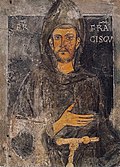
Giovanni di Pietro di Bernardone, known as Francis of Assisi, was an Italian mystic, poet and Catholic friar who founded the religious order of the Franciscans. He was inspired to lead a Christian life of poverty as a beggar and itinerant preacher. One of the most venerated figures in Christianity, Francis was canonized by Pope Gregory IX on 16 July 1228. He is commonly portrayed wearing a brown habit with a rope tied around his waist, featuring three knots that symbolize the three Franciscan vows of poverty, chastity, and obedience.

Federico Fellini was an Italian film director and screenwriter. He is known for his distinctive style, which blends fantasy and baroque images with earthiness. He is recognized as one of the greatest and most influential filmmakers of all time. His films have ranked highly in critical polls such as that of Cahiers du Cinéma and Sight & Sound, which lists his 1963 film 8+1⁄2 as the 10th-greatest film.

Roberto Gastone Zeffiro Rossellini was an Italian film director, screenwriter and producer. He was one of the most prominent directors of the Italian neorealist cinema, contributing to the movement with films such as Rome, Open City (1945), Paisan (1946), and Germany, Year Zero (1948). He is also known for his films starring Ingrid Bergman, Stromboli (1950), Europe '51 (1952), Journey to Italy (1954), Fear (1954), and Joan of Arc at the Stake (1954).

Amarcord is a 1973 comedy-drama film directed by Federico Fellini, a semi-autobiographical tale about Titta, an adolescent boy growing up among an eccentric cast of characters in the village of Borgo San Giuliano in 1930s Fascist Italy. The film's title is a univerbation of the Romagnol phrase a m'arcôrd. The title then became a neologism of the Italian language, with the meaning of "nostalgic revocation". The central role of Titta is based on Fellini's childhood friend from Rimini, Luigi Titta Benzi. Benzi became a lawyer and remained in close contact with Fellini throughout his life.

Rome, Open City, also released as Open City, is a 1945 Italian neorealist war drama film directed by Roberto Rossellini and co-written by Sergio Amidei, Celeste Negarville and Federico Fellini. Set in Rome in 1944, the film follows a diverse group of characters coping under the Nazi occupation, and centers on a Resistance fighter trying to escape the city with the help of a Catholic priest. The title refers to the status of Rome as an open city following its declaration as such on 14 August 1943. The film is the first in Rosselini's "Neorealist Trilogy", followed by Paisan (1946) and Germany, Year Zero (1948).
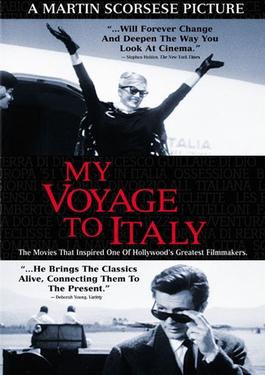
My Voyage to Italy is a personal documentary by acclaimed Italian-American director Martin Scorsese. The film is a voyage through Italian cinema history, marking influential films for Scorsese and particularly covering the Italian neorealism period.
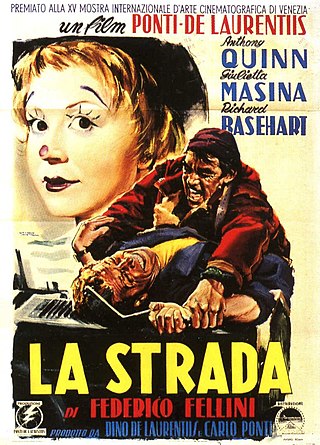
La strada is a 1954 Italian drama film directed by Federico Fellini and co-written by Fellini, Tullio Pinelli and Ennio Flaiano. The film tells the story of Gelsomina, a simple-minded young woman bought from her mother by Zampanò, a brutish strongman who takes her with him on the road.

I vitelloni is a 1953 Italian comedy drama film directed by Federico Fellini from a screenplay written by himself, Ennio Flaiano and Tullio Pinelli. It stars Franco Interlenghi, Alberto Sordi, Franco Fabrizi, Leopoldo Trieste, and Riccardo Fellini as five young Italian men at crucial turning points in their small town lives. Recognized as a pivotal work in the director's artistic evolution, the film has distinct autobiographical elements that mirror important societal changes in 1950s Italy.

Juniper, also known as Brother Juniper, called "the renowned jester of the Lord", was one of the original followers of Francis of Assisi. Not much is known about Juniper before he joined the friars. In 1210, he was received into the Order of Friars Minor by Francis himself. "Would to God, my brothers, that I had a whole forest of such Junipers," Francis would delightfully pun.

The Little Flowers of St. Francis is a florilegium, divided into 53 short chapters, on the life of Saint Francis of Assisi that was composed at the end of the 14th century. The anonymous Italian text, almost certainly by a Tuscan author, is a version of the Latin Actus beati Francisci et sociorum eius, of which the earliest extant manuscript is one of 1390 AD. Luke Wadding ascribes the text to Ugolino da Santa Maria, whose name occurs three times in the Actus. Most scholars are now agreed that the author was Ugolino Brunforte.

Paisan is a 1946 Italian neorealist war drama film directed by Roberto Rossellini. In six independent episodes, it tells of the Liberation of Italy by the Allied forces during the late stage of World War II. The film premiered at the Venice International Film Festival and received numerous national and international prizes.

Aldo Fabrizi was an Italian actor, director, screenwriter and comedian, best known for the role of the heroic priest in Roberto Rossellini's Rome, Open City and as partner of Totò in a number of successful comedies.

Giovanna Ralli,, is an Italian stage, film and television actress.

Franco Fabrizi was an Italian actor.

Cops and Robbers is a 1951 Italian cult comedy film directed by Steno and Mario Monicelli. It stars the famous comedian Totò, and the cinematographer was the future film director Mario Bava. It was produced by Dino De Laurentiis and Carlo Ponti.
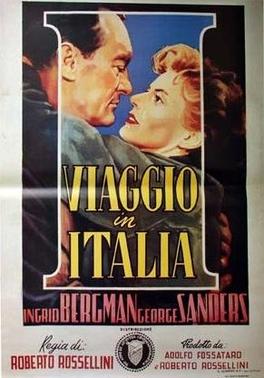
Journey to Italy, also known as Voyage to Italy, is a 1954 drama film directed by Roberto Rossellini. Ingrid Bergman and George Sanders play Katherine and Alex Joyce, a childless English married couple on a trip to Italy whose marriage is on the point of collapse until they are miraculously reconciled. The film was written by Rossellini and Vitaliano Brancati, but is loosely based on the 1934 novel Duo by Colette. Although the film was an Italian production, its dialogue was in English. The first theatrical release was in Italy under the title Viaggio in Italia; the dialogue had been dubbed into Italian.
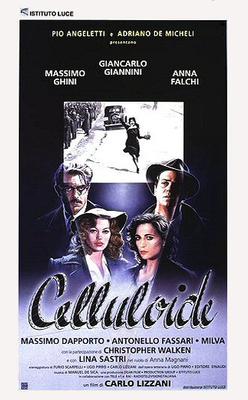
Celluloide is a 1996 Italian historical drama film directed by Carlo Lizzani from a screenplay by Furio Scarpelli, Ugo Pirro and Lizzani, based on the 1983 novel of the same name by Pirro. It stars Giancarlo Giannini, Massimo Ghini, Anna Falchi, and Lina Sastri.

Brunello Rondi was an Italian screenwriter and film director, best known for his frequent script collaborations with Federico Fellini.
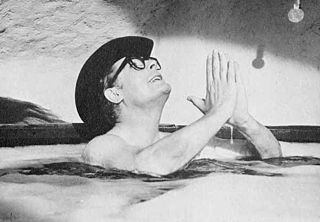
The list of the 100 Italian films to be saved was created with the aim to report "100 films that have changed the collective memory of the country between 1942 and 1978". Film preservation, or film restoration, describes a series of ongoing efforts among film historians, archivists, museums, cinematheques, and non-profit organizations to rescue decaying film stock and preserve the images they contain. In the widest sense, preservation assures that a movie will continue to exist in as close to its original form as possible.
Rod E. Geiger (1915–2000) was an American movie producer and director, Instrumental for his contributions to Italian Neorealism, working with Federico Fellini and Roberto Rossellini. Credited in the book "The Adventures of Roberto Rossellini, by Tag Gallagher" as the man who more than any single individual was to make Rossellini and the new Italian cinema famous around the world. He was also known for his marriage to Katja of Sweden, a Swedish fashion designer.





















